
|







(alphabetical and illustrated) Introduction | A - 1 | A - 2 | B - 1 | B - 2 | C - 1 | C - 2 | C - 3 | D | E | F G - H | I - J - K | L - M | N - O | P | Q - R | S - 1 | S - 2 | T | U - V - W - X - Y - Z |
|
|
|
|
| a combination of the terms "black" and "exploitation"; refers mainly to sensational, low-budget films in the 1970's featuring mostly African-American casts (and directors), that broke the mold of black characterization in feature films; usually emphasized fads of the time in hairstyles, music and costuming, and also brutality, sleazy sex, street-life, racist and militant attitudes, etc. | 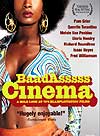 Examples: Sweet
Sweetback's Badasssss Song (1971), Superfly (1972), and
Ralph Bakshi's animated Coonskin (1975); a documentary titled Baadasssss
Cinema (2003) from the Independent Film Channel by filmmaker Isaac
Julien examined the early 70s and the phenomenon of blaxploitation
films Examples: Sweet
Sweetback's Badasssss Song (1971), Superfly (1972), and
Ralph Bakshi's animated Coonskin (1975); a documentary titled Baadasssss
Cinema (2003) from the Independent Film Channel by filmmaker Isaac
Julien examined the early 70s and the phenomenon of blaxploitation
films |
|
| used to refer to Britain | ||
| the sound-deadening housing a noisy movie camera is put in to prevent the recording of extra sounds by the camera's motor or sound equipment | ||
| originally referred to a large bomb that would destroy an entire city block during World War II; now in common usage, an impactful movie that is a huge financial success - usually with box-office of more than $200 million (the new benchmark by the early 2000s, after the original mark was $100 million) upon release in North America; ticket lines for blockbusters literally go around the 'block'; also known as box-office hit; the term may also refer to a costly film that must be exceptionally popular in order to recoup its expenses and make a profit; the opposite of a blockbuster is a bomb, flop, or turkey. See All-Time Box-Office Bombs/Flops. | 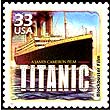 Examples:
The term was first applied to Steven Spielberg's Jaws
(1975), often acknowledged as the first blockbuster; James Cameron's Titanic
(1997) was also a massive blockbuster hit. See All-Time
Top 100 Box-Office Hits. Examples:
The term was first applied to Steven Spielberg's Jaws
(1975), often acknowledged as the first blockbuster; James Cameron's Titanic
(1997) was also a massive blockbuster hit. See All-Time
Top 100 Box-Office Hits. |
|
| the process of figuring out where the camera
goes, how the lights will be arranged, and what the actors' positions
and movements - moment by moment - are for each shot or take;
often, the specific staging of a film's movements are worked out by the
director, often with stand-ins and the lighting crew before actual
shooting |
||
| an actual error or mistake (misplaced action, or mis-spoken dialogue by a performer), usually embarrassing or humorous, made by a performer during filming; also known as a goof, flaw or flub; see also continuity |  Examples:
in Jurassic Park (1993),
the name of a common dinosaur (Stegosaurus) was spelled incorrectly;
in the cafeteria scene at Mt. Rushmore in North
by Northwest (1959), a boy extra in the cafeteria of Mt. Rushmore
plugs his ears before a gun goes off; Examples:
in Jurassic Park (1993),
the name of a common dinosaur (Stegosaurus) was spelled incorrectly;
in the cafeteria scene at Mt. Rushmore in North
by Northwest (1959), a boy extra in the cafeteria of Mt. Rushmore
plugs his ears before a gun goes off;  or
in The Invisible Man (1933) when Claude Rains strips to avoid
police, he leaves visible shoe prints in the snow; probably the most
frequent flub in films is the appearance of the boom mike or
in The Invisible Man (1933) when Claude Rains strips to avoid
police, he leaves visible shoe prints in the snow; probably the most
frequent flub in films is the appearance of the boom mike |
|
| an optical process - the enlargement of a photographic image or film frame; often used to create 70mm release prints from original 35mm films |
|
|
or blue-screen shot |
a special-effects process whereby actors work in front of an evenly-lit, monochromatic (usually blue or green) background, screen, or backdrop. The background is then replaced (or matted) in post-production by chroma-keying or optical printer, allowing other footage or computer-generated images (CGI) to form the background image; since 1992, most films use a green-screen |  Example: a bluescreen for Jurassic Park III (2001), or greenscreen for Charlie's Angels (2000) 
|
| another name for a commercial or advertisement (usually for TV) | ||
(or double) |
a performer who takes the place of an actor in scenes that require a close-up of body parts without the face visible, often for nude scenes requiring exposed close-ups (considered distasteful by some actors), or scenes requiring physical fitness; not to be confused with stunt double or stand-in |  Example:
Marli Renfro, a hired double for Janet Leigh for test scenes in the
shower scene in Psycho (1960). Example:
Marli Renfro, a hired double for Janet Leigh for test scenes in the
shower scene in Psycho (1960). |
| refers to the burgeoning film industry of India, the world's biggest film industry, centered in Bombay (now Mumbai); the etymology of the word: from Bo(mbay) + (Ho)llywood; unlike Hollywood, however, Bollywood is a non-existent place. |  Example:
Mira Nair's Monsoon Wedding (2001), a modern Indian film set
in current-day New Delhi, echoes the Bollywood spirit with typical
traits including music and dance, romance, and comedy. Also the Best
Picture winning Slumdog Millionaire (2008). Example:
Mira Nair's Monsoon Wedding (2001), a modern Indian film set
in current-day New Delhi, echoes the Bollywood spirit with typical
traits including music and dance, romance, and comedy. Also the Best
Picture winning Slumdog Millionaire (2008). |
|
| a term denoting scenes at the beginning and end of a film that complement each other and help tie a film together; aka framing device | 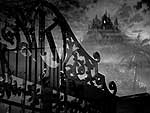 Example:
the view of Xanadu's gate in Citizen Kane (1941) Example:
the view of Xanadu's gate in Citizen Kane (1941) |
|
| a traveling or moveable counter-balanced pole (also called fishpole or fishing rod), arm, or telescoped extension device upon which a microphone, light or camera can be suspended overhead above a scene and outside the frame during filming (by a boom operator or boom man); for example, a microphone (mike) boom, a camera boom, or a light boom; the most common film mistake is the appearance of the boom mike (or its shadow) in the frame; a mechanical boom mike is known as a 'giraffe.' |  Example: A microphone boom stand from the late 40s |
|
| a continuous single shot made from a moving boom, assembled like a montage, and incorporating any number of camera levels and angles. |  Example:
Hitchcock used this filming technique for almost all of Rope (1948). Example:
Hitchcock used this filming technique for almost all of Rope (1948). |
|
| an illegally copied, unauthorized, and/or distributed version of a copyrighted film/video/DVD, often of second-rate quality; also termed pirated. | 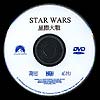 Example: a bootlegged DVD version of Star Wars (1977), mastered using an Asian release of the special edition laserdisc. |
|
| refers to a device to reflect light during filming; the board is usually a large white surface made of foam or poster board | ||
| refers to purging anything considered disturbing, vulgar, or adult in content in order to make it sanitized for mass market consumption and appropriate for children; originally a literary term derived from the name of Englishman Thomas Bowdler who published a 'censored' Family Shakespeare version in the early 1800s. | Examples: Cat on a Hot Tin Roof (1956) removed the stage play's references to homosexuality; Disney's Snow White and the Seven Dwarfs (1937) was a 'bowdlerized,' prudish and sterilized version of the original Grimm fairy tale, with darker and more adult content | |
| the measure of the total amount of money or box-office receipts paid by movie-goers to view a movie; also referred to as B. O. or gross; usually divided into domestic grosses (unadjusted and adjusted for inflation), and worldwide grosses; films with great box-office results or a strong and outstanding performance are often termed 'boff', 'boffo', 'boffola', 'whammo', 'hotsy', or 'socko'. | 
|
|
| the act of shooting a scene several times with different F-stops to try and get a certain desired effect | ||
| a transitional type of shot used to cover or 'bridge' a jump in time or place or other discontinuity; see also audio bridge and match-cut |  Examples
of bridging shots include: falling calendar pages, newspaper headlines,
railroad wheels, seasonal changes, and maps, such as the transitional
travel maps (reminiscent of serials) in Raiders
of the Lost Ark (1981) Examples
of bridging shots include: falling calendar pages, newspaper headlines,
railroad wheels, seasonal changes, and maps, such as the transitional
travel maps (reminiscent of serials) in Raiders
of the Lost Ark (1981) |
|
| a subgenre of film (comedies, westerns, dramas, action films, road films, etc.) in which two mismatched persons (usually males) are forced to work together, often a pair of police cops; situations are often contrived to present the pair with challenges or strains that both strengthen their bond and weaken it; buddy films are often action/comedy films with witty dialogue between the two characters and sometimes the inclusion of a love triangle; has been extended to include female buddies; compare to fish-out-of-water tale | 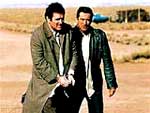 Examples: The
Defiant Ones (1958), Butch Cassidy
and the Sundance Kid (1969), Midnight
Cowboy (1969), 48 HRs (1984), Lethal
Weapon (1987), Midnight Run (1988) (pictured), Thelma & Louise
(1991), Unforgiven (1992), Wayne's
World (1992), Dumb and Dumber (1994), Leon (or The Professional)
(1994), The Shawshank Redemption (1994),
Men in Black (1997) Examples: The
Defiant Ones (1958), Butch Cassidy
and the Sundance Kid (1969), Midnight
Cowboy (1969), 48 HRs (1984), Lethal
Weapon (1987), Midnight Run (1988) (pictured), Thelma & Louise
(1991), Unforgiven (1992), Wayne's
World (1992), Dumb and Dumber (1994), Leon (or The Professional)
(1994), The Shawshank Redemption (1994),
Men in Black (1997) |
|
| using dramatic devices such as increased tempo, volume, and emphasis to bring a scene to a climax | ||
| usually refers to the pre-film segment of pre-made film that contains studio trademark and logo or title identification; also refers to a period of positive financial growth (i.e., it was a 'bumper year' for films) | 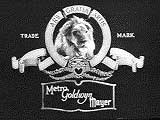 Examples:
MGM's lion, Universal's spinning globe, DreamWorks' cloudy scene with
boy fishing, etc. Examples:
MGM's lion, Universal's spinning globe, DreamWorks' cloudy scene with
boy fishing, etc. |
|
| slang for the sense of excitement, expectancy, and hype that surrounds a film, an actor, or a director | ||
| a soundtrack of natural, atmospheric, on-location background noise that is added to the re-recorded (or looped) track of actors' dialogue and other sound effects recordings to create a more realistic sound; aka referred to as room tone or matching ambient sound; a wild track or sound refers to a soundtrack w/o any synchronized picture accompanying it (e.g., the sounds of a playground) | ||